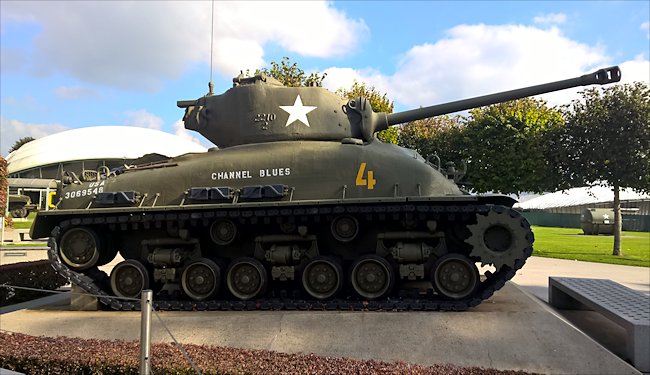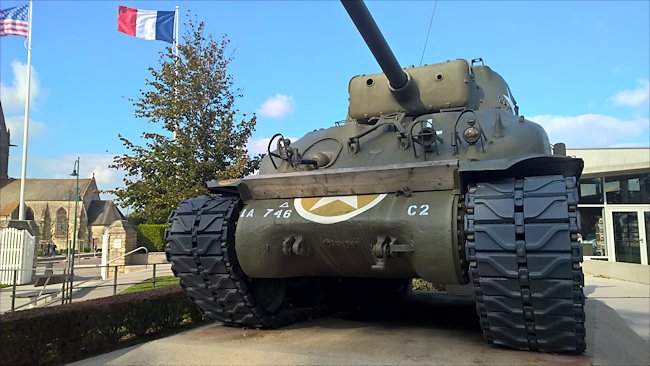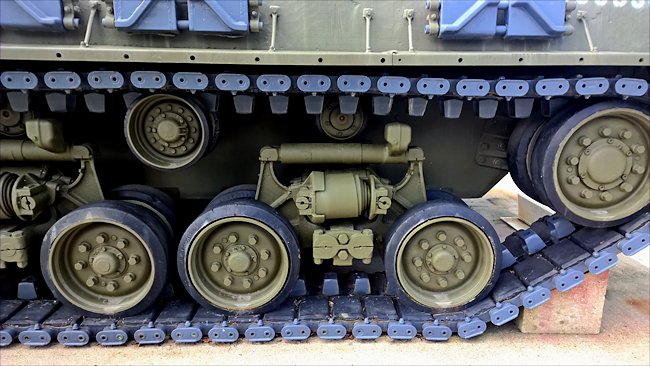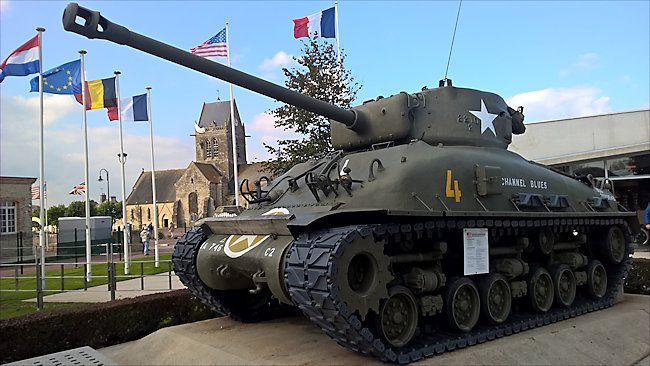M4A1(76)W HVSS Sherman Tank
This M4A1(76)W HVSS Sherman Tank (Sometimes called the M4A1E8 Easy 8) is part of the WW2 D-Day landings display at the US Airborne Forces Museum in Saint-Mere-Eglise. The Museum is built on the site of the house that was bombed and burnt down on D-Day that is seen on the film the Longest Day. It was the light from this fire that enabled the Germans stationed in the town to shot so many paratroopers as they were blown off course and landed in Saint-Mere-Eglise. The problem is that this version of the Sherman tank never took part in the D-Day landings on 6th June 1944 or the battle for Normandy. The first 'Easy Eight' M4A1(76)W HVSS Sherman tanks only arrived in Europe in December 1944.

M4A1(76)W HVSS Easy Eight Sherman Tank at the US Airborne Forces Museum in Saint-Mere-Eglise.
Location
Head towards Saint-Mere-Eglise. Either use the town center setting on your Sat-Nav or type in Rue Eisenhower, Saint-Mere-Eglise. Both will get you to the large car park outside the museum opposite the town church. Look out for the paratrooper hanging from the church roof by his parachute in memory of US Paratrooper John Steel.
Specification
The M4A1(76)W HVSS Sherman tank was fitted with the long barreled high velocity 76mm M1 gun. The tank had a 30-60 Browning M1919A4 machine gun on the left of the main gun and one in a ball mount in the hull. What made this tank different to other Shermans was the width of the tracks. They were 23 inches wide rather than the normal 16 inch width. This gave the tank the ability to cross wet muddy ground without sinking. They were also fitted with new Horizontal Volute Suspension (HVSS)
The tank was powered by a Continental R975 C1 9 cylinder radial petrol engine that produced 400 hp. The tank had a top road speed of 25 mph (40 km/h). It had an operational range of 120 miles (193 km) before needing to be refueled. The five man tank crew included the commander, driver, gunner, loader and co-driver/hull machine gunner.

This version of the Sherman can be identified by its 23 inch wide tracks
Deployment in Normandy 1944
The Americans and British found that in the winter the Sherman tanks in Italy had problems crossing really water soaked muddy and snow covered ground. Their tank tracks were too narrow and sank in the mud under the weight of the tank. the interim solution was to fit track extensions called 'duck-bills' The Sherman M4A1 outside the Bayeux Memorial Museum of the Battle of Normandy has them fitted to its tracks.
Initially these new tanks were called M4A1(76)W HVSS Sherman Tank with 23 inch track. This was too much of a mouth full so it got abbreviated to M4A3E8 after the war. The term 'Easy Eight' was a post WW2 nickname refering to the V8 engine. It was used by tank crews during the fight to Berlin in Germany. These tanks were issued to all four armies attached to Bradley's 12th Army Group to replace the tank losses that occurred in the Battle of the Bulge in the Belgium Ardennes.

This version of the Sherman tank was fitted with the new and improved HVSS suspension to cope with the additional weight.
In December 1944 21 M4A1(76)W HVSS Shermans were issued to the 12th Army Group. In January 1945 a further 114 arrived. In February 153 were delivered. In March 115 were issued and in April a final batch of 349 were made operational. They were all armed with the 76mm gun and had HVSS suspension with the wider 23 inch tracks.
When compared with the British 17pdr Firefly Sherman tank the US 76mm armed Shermans were not as good at knocking out German tanks. Yes they were better than the Sherman tanks armed with the standard short barrel 75mm gun, but they could not penetrate the same thickness of enemy armour as the British 17pdr gun. At 1km the 17pdr gun could penetrate 150mm of vertical armour. The 76mm gun could only penetrate 106mm. At 500m the 17pdr gun could penetrate 165mm of vertical armour. The 76mm gun could only penetrate 116mm.

The M4A1(76)W HVSS Sherman tank was armed with a 76mm gun
D-Day 1944 books

